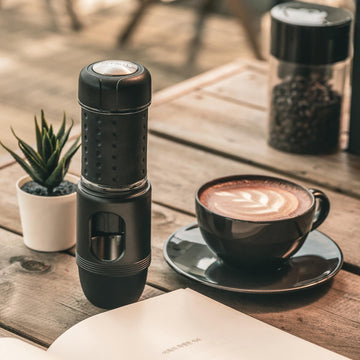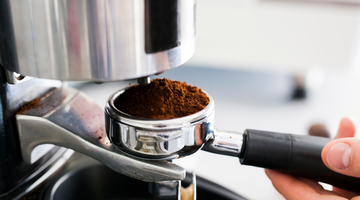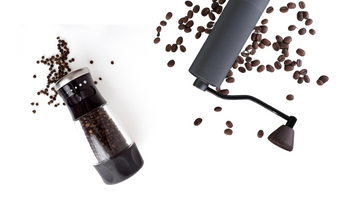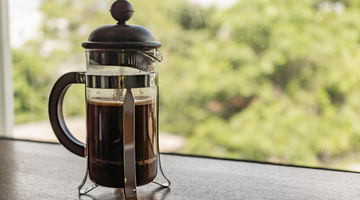Grinding beans for espresso is an essential step in the coffee-making process that can significantly affect the taste and quality of your espresso shot. The espresso bean grind size determines how quickly water can pass through the coffee grounds, extracting flavors and aromas to create the perfect espresso.
In this guide, we'll explore everything you need to know about grinding for espresso, including the ideal grind size, the best grinders, and tips for achieving consistent results.
Why you need to get espresso grinding right
Espresso grinding is the process of breaking down coffee beans into smaller pieces to prepare them for brewing.
Grind sizes
The grind size affects the extraction rate and flavor profile of the espresso. A too-coarse grind can result in under-extraction, producing weak and sour coffee, while a too-fine grind can lead to over-extraction, resulting in bitter and harsh flavors.
Extraction time and flavor
The espresso bean grind size influences how quickly water flows through the coffee grounds. Finer grinds slow the extraction process, allowing more flavors to be extracted, while coarser grinds speed up the process.
Balancing extraction
Achieving the right grind size is essential for balanced extraction, where the espresso exhibits a harmonious blend of sweetness, acidity, and bitterness.
Choosing the right espresso beans
Choosing the best beans for espresso involves considering several key factors to ensure a rich, balanced shot. Opt for high-quality Arabica beans, known for their nuanced flavors and natural sweetness. Look for freshly roasted beans, ideally within the past two weeks, as freshness significantly impacts flavor and aroma.
Medium to dark roasts are typically preferred for espresso due to their fuller body and reduced acidity. Additionally, sourcing beans from reputable suppliers who provide information on the beans' origin, processing method, and roast date can greatly enhance your espresso experience. Ultimately, experimenting with different beans and roasts will help you find the perfect match for your taste preferences.
Types of espresso grinders

To get your espresso grind right, start with the best coffee grinder for your espresso. There are two main types of coffee grinders, burr and blade, but they offer very different results.
Burr grinders are like the Swiss army knives of grinders. Designed for precision and consistency with adjustable grind size options, they're not just ideal for espresso grinding, but other brewing methods as well. Burr grinders also come in both manual and electric versions, like STARESSO's Discovery and Discovery II Grinders, both offering the same high-quality coffee grind.
Blade grinders, on the other hand, are a bit of a one-trick pony. They work like a blender, chopping up coffee beans without much regard for the outcome. Blade grinders are fine for brewing types that don't require a fine or uniform grind, such as French press or pour-over.
How fine to grind espresso beans
For the perfect espresso shot, you need a fine grind around the same size as table salt. This grind size is essential for espresso brewing, which uses pressure to extract the flavors quickly. Espresso requires a larger surface area to be exposed to water, while other brewing methods with larger grinds only need a smaller area.
How to grind beans for espresso
Using a burr grinder
Follow these steps to grind beans for espresso using a burr grinder.
-
Set the grind size: Adjust the grinder to a 'fine' setting. This is usually a low number or denoted by a small 'grind' circle.
-
Measure the beans: Weigh your beans using coffee scales for precise measurement. If you don't own a set of scales, use a tablespoon. For a shot of espresso, you'll need about 0.18 to 0.36 ounces (5 to 10 grams) of whole coffee beans or 0.75 to 1.5 tablespoons.
-
Grind the beans: Since you're using a burr grinder, like STARESSO Discovery II Grinder, just pop in your beans and hit the button for a consistent grind that's perfect for espresso.
-
Test and tweak: Brew a shot and adjust the grind size if necessary. If the espresso is too weak, lower the grind size on your grinder. If it's too bitter, then knock it up one.
How to solve uneven espresso grinding
If your espresso doesn't turn out quite how you expected, there could be a few factors. Let's look into some common issues that can occur when grinding for espresso.
If your coffee grinds lack consistency, make sure that your grinder is clean and in good working order. Wipe out the oils and bean remnants after using the grinder. Once in a while, you should also maintain your burr grinder, checking burr alignment to avoid uneven grinding. The quality of your grinder also plays a part here, so make sure you invest in a reliable burr grinder, like the STARESSO Discovery II Grinder which will grind perfectly every time. When grinding for espresso, make sure to choose high-quality beans as this can also help achieve a more even grind.
Espresso grinding frequently asked questions
How fine should I grind espresso beans?
Espresso beans should be ground to a fine consistency, similar to that of table salt. This grind size allows for optimal extraction, balancing the flavors and producing a rich, concentrated shot of espresso. Adjustments may be necessary depending on the specific beans and espresso machine being used.
Why does my espresso taste bitter?
A bitter taste in espresso is often due to over-extraction, which can occur if the grind is too fine, brewing time is too long, or the temperature is too high. To correct this, try adjusting the grind size to be slightly coarser, reduce the brewing time, or lower the water temperature.
Can I use a blade grinder for espresso?
While you can use a blade grinder for espresso, it is not recommended. Blade grinders tend to produce an uneven grind, which can result in inconsistent extraction and a lower-quality espresso. Burr grinders are preferred for their ability to create a consistent and precise grind, which is essential for making great espresso.







